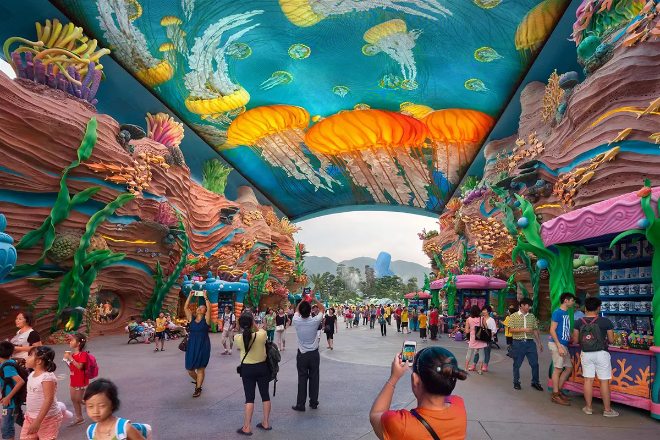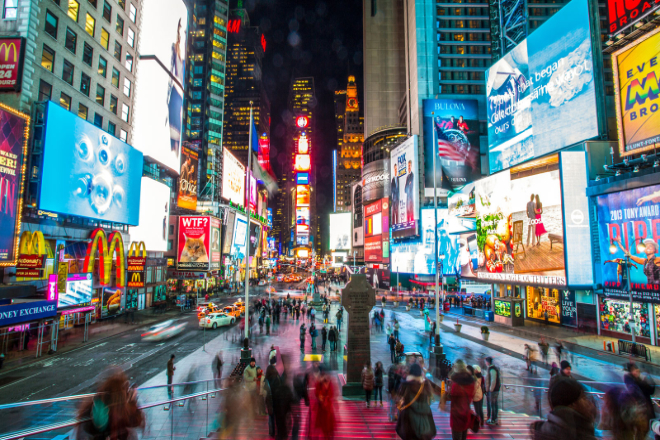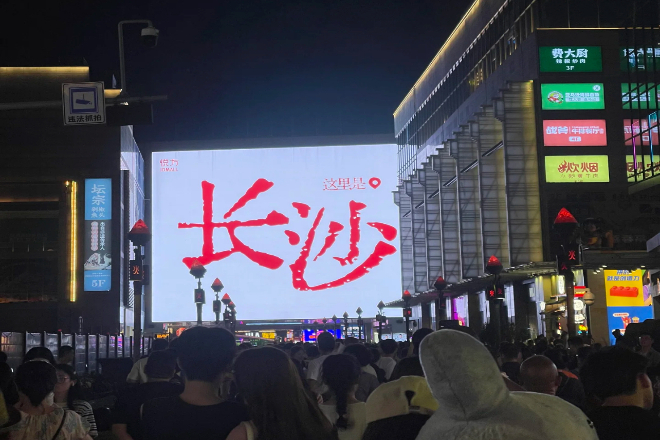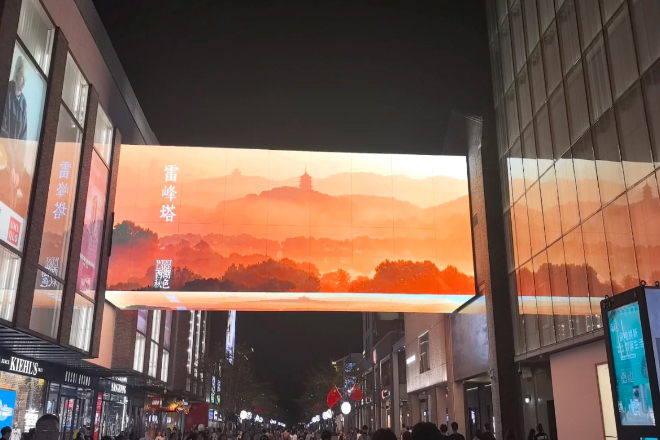Introducción
In today’s fast-paced tourism era, how can tourists obtain accurate and rich tourism information in a short time? The pantalla LED may give the answer.
It not only changes the limitations of traditional information dissemination but also brings new opportunities to the tourism industry with its unique advantages.
So, how does an LED display screen optimize the efficiency of tourism information dissemination?
Tabla de contenido
1. Advantages of LED display screen in tourism information dissemination

The special advantage of the LED display screen is that it is bright and clear.
Even under the strong sun outdoors or when the lights are very bright at night, the information on it can be seen clearly.
This is very important for tourist attractions. For example, at the seaside or in the mountains, ordinary screens may be blurred by the sun.
But LED display screens can display information steadily without worrying about reflection or unclear reading.
Moreover, it can also play dynamic images and videos, which is much more interesting than dry text.
For example, putting a wonderful promotional video at the entrance of the scenic spot can catch the attention of tourists at once, make them more interested in the scenic spot, and better show the charm of the scenic spot.
Another great feature of LED display is that it can update information at any time. Tourism information must be timely.
For example, if the weather suddenly changes, the opening hours of scenic spots are adjusted.
Or there are temporary activities, the LED display can be updated immediately so that tourists can know it the first time, which is convenient for them to arrange their own itinerary.
For example, when encountering heavy rain, the scenic spot can remind tourists to take shelter or adjust the route in time through the screen.
Moreover, it can also adjust the content according to the needs of different tourists.
For example, when foreign tourists come, the screen can be switched to multilingual introductions; when family tourists with children come, more information about parent-child activities can be displayed.
In this way, no matter what type of tourists, they can find what they need, which feels very considerate.
The LED display is like an “information treasure box” that can display text, pictures and videos at the same time to meet the needs of various information dissemination.
Text can briefly introduce the scenic spot, pictures can show the beautiful scenery, and videos can vividly tell the story behind the scenic spot or show special activities.
For example, in the tourist service centre, the screen can simultaneously display the scenic spot map, historical and cultural videos and tourist evaluations so that tourists can understand comprehensive information at one time.
Moreover, it can integrate various tourism information, such as introductions to scenic spots, cultural backgrounds, travel guides, recommendations for nearby food, accommodation and transportation, etc. Tourists don’t have to look around and can get it all on one screen.
For example, in large theme parks, the screen can display the queue time, performance schedule and park map of amusement projects, which is convenient for tourists to plan how to play and make the trip more smooth.
2. Analysis of the current situation and challenges of tourism information dissemination

1). Limitations of traditional dissemination methods
Traditional tourism information dissemination methods mainly rely on paper promotional materials, static display boards and other means.
However, these methods have many limitations.
First, paper promotional materials are easy to lose and are not updated in time, which makes it difficult to meet tourists’ needs for the latest information.
Secondly, static display methods lack appeal and make it difficult to stand out from the crowd and attract tourists’ attention.
For example, although the propaganda column at the entrance of the scenic spot is rich in information, most of them are simple combination of text and pictures, lacking dynamic effects, and it is difficult for tourists to stop and take a closer look.
2). Diversification of tourist needs
With the continuous development of the tourism market, tourists’ needs are becoming more and more diversified.
There are obvious differences in the needs of different tourists for tourism information.
For example, in terms of language, foreign tourists need multilingual support, while domestic tourists may pay more attention to detailed information in the local language.
In terms of content depth, some tourists may only need a simple introduction to the attractions, while others want to understand a deeper historical and cultural background.
In addition, the problem of information overload is becoming increasingly serious.
Tourists find it difficult to quickly obtain key information in a large amount of information, resulting in low efficiency in information acquisition.
3). Fragmentation of information dissemination
At present, tourism information is scattered across multiple channels, including scenic spot official websites, social media, travel guide websites, offline promotional materials, etc., lacking effective integration.
This fragmented dissemination method makes it difficult for tourists to form a complete tourism information system.
For example, tourists may see different information about the same scenic spot on different platforms but cannot effectively integrate them together, thus affecting their decision-making efficiency and travel experience.
In addition, information fragmentation may also cause tourists to spend a lot of time and energy in obtaining information but still cannot obtain comprehensive and accurate information.
3. Strategies for optimizing the efficiency of tourism information dissemination

1). Content optimization
In order for LED displays to play their best role, the content must be accurate and practical.
First, it is necessary to customize personalized content according to the age, gender, cultural background, etc. of tourists.
For example, for young tourists, more interactive, exciting and fun projects can be displayed.
For family tourists, parent-child activities and children’s amusement facilities can be introduced.
At the same time, key information should be highlighted, and important information, such as scenic spot features, transportation routes, opening hours, etc., should be displayed first to avoid redundant information.
In addition, considering the needs of international tourists, LED display screens must provide multilingual support to ensure that tourists with different language backgrounds can easily obtain information.
2). Optimización del diseño
The installation location of LED display screens is crucial. It should be installed at key locations such as transportation hubs, tourist distribution centres, and scenic spot entrances to ensure that tourists can see information for the first time in these must-go places.
At the same time, a complete tourism information dissemination network is formed through multi-screen linkage.
For example, multiple display screens are set up between different scenic spots in the scenic area to achieve seamless coverage of information.
In addition, interactive design can be added, such as setting up a touch screen function so that tourists can query the content they are interested in by touch.
Or through the QR code scanning function, guide tourists to obtain more detailed information and enhance the sense of participation of tourists.
3). Technical optimization
Use modern technology to enhance the function of LED display screens. An intelligent push system can be installed to accurately push relevant information according to the location and behavior habits of tourists.
For example, when tourists approach a certain scenic spot, the display screen can automatically switch to a detailed introduction of the scenic spot.
At the same time, through data analysis, understand the needs and preferences of tourists and continuously optimize the information display content.
In addition, the use of energy-saving and environmental protection technologies can reduce the energy consumption of LED display screens and extend their service life, which not only saves costs but also conforms to the concept of environmental protection.
4). Visual design optimization
The visual effect directly affects the attention of tourists and the efficiency of information reception.
On the LED display screen, choose colours and fonts suitable for the tourism theme to enhance the visual effect.
For example, use bright colours to attract tourists’ attention and choose clear and easy-to-read fonts to ensure that the information is conveyed correctly.
Use animations and videos reasonably, but be careful to avoid too much information to avoid visual fatigue for tourists.
Through clever layout and design, highlight important information so that tourists can grasp the key content at a glance.
5). Integrate with social media
LED display screens can not only display information but also be deeply integrated with social media.
For example, set up an information-sharing function so that tourists can directly share travel information to social media platforms through the display screen to attract more attention.
At the same time, link with social media platforms to display tourists’ comments and suggestions in real time for other tourists to refer to.
You can also guide hot topics through the display screen to enhance tourists’ sense of participation and enhance the interactivity and attractiveness of the scenic spot.
6). Collaborate with other communication channels
LED display screens cannot exist in isolation but should work in coordination with other communication channels.
For example, they can be combined with traditional media such as scenic spot guide maps and brochures to form a complementary effect.
Mark the location of the LED display screen on the guide map to guide tourists to view more detailed information.
Link with online platforms such as travel websites and apps and the information that tourists see on the APP can also be displayed on the LED display screen simultaneously.
At the same time, cooperate with scenic spot staff, who can guide tourists to view important information on the LED display screen and provide instant travel consultation.
4. Excellent case analysis in the travel industry of various countries
1). Huachang Dragon Valley in Nanjing, China
The giant creative LED speaker screen of Nanjing Huachang Dragon Valley Theme Park is a model of the perfect integration of LED special-shaped screens and cultural tourism industries.
The world’s largest speaker screen combines traditional Chinese architectural style with stunning dragon elements.
It is unique from its appearance design to its visual effects, providing visitors with a multi-angle, three-dimensional visual experience.
2). Marina Bay Sands Hotel, Singapore
The SkyPark rooftop of Marina Bay Sands Hotel, Singapore, is equipped with eye-catching LED screens.
These screens span the three towers of the resort, playing dazzling light shows and various eye-catching dynamic content against the backdrop of the city skyline.
Through the LED screens, the hotel not only enhances its visual appeal but also provides visitors with a unique night view experience.
3). Times Square, New York, USA
Times Square in New York is one of the most famous landmarks in the world. It has a lot of LED screens.
It can be said that this is a tourist attraction composed of LED screens.
These large screens not only display rich advertising content but also realize the digital upgrade of outdoor advertising through cutting-edge digital technology, becoming a beautiful landscape at the “crossroads of the world”.
Its high brightness and clarity display effect can be clearly seen even in strong daylight, providing visitors with a shocking visual experience.
5. Future development trend of LED display screens in the tourism industry

1). Technological innovation trend
In the future, LED display screens will be clearer, more energy-efficient, and smarter. New technologies make the screen resolución higher, the picture is more delicate, and it can also save power.
The screen can also automatically adjust the brillo according to the light, which is not dazzling during the day and clearer at night.
Combined with AR/VR technology, tourists may see virtual scenes, such as the restoration of ancient buildings in scenic spots.
The advancement of packaging technology also makes the screen more durable and less expensive. In the future, there will be more and more places to use such screens in scenic spots.
2). Cambios en la demanda del mercado.
Tourists now prefer vivid and interactive travel experiences. LED screens can display detailed introductions and historical backgrounds and even play videos by touching or scanning codes.
Tourists also prefer personalized content. Future screens can adjust the display content according to the language and preferences of tourists.
For example, when foreign tourists approach, they switch to English, and family tourists give priority to parent-child activities.
The intelligent push system will also push the information they need most according to the location and behavior of tourists, such as automatically popping up introductions when they walk near scenic spots so that tourists will not miss exciting content.
6. Conclusión
Through the optimization of content, layout, technology, visual design and other aspects, LED display screens have shown great potential in the dissemination of tourism information.
From the creative speaker screen of Nanjing Huachang Dragon Valley to the stunning large screen of New York Times Square, these excellent cases have drawn a blueprint for the future dissemination of tourism information for us.
Finalmente, si quieres saber más sobre las pantallas LED, Por favor póngase en contacto con nosotros.
Te puede interesar:
Other articles about tourism Industry LED display:
